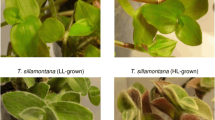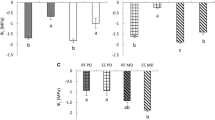Abstract
Leaf anatomy and irradiance-dependent leaf transmittance changes serving as irradiance acclimation mechanisms in leaves were studied in two ecologically contrasting Tradescantia species, a shade plant T. fluminensis Vell. and a sun plant T. sillamontana Matuda, grown at different irradiances. A dramatic increase in leaf thickness (2 to 4-fold) under a high growth irradiance (800 μmol m−2 s−1) compared with a low growth irradiance (60 μmol m−2 s−1), achieved mainly by expansion of the epidermis, was recorded in both species. The effect took place on the background of modest changes in mesophyll thickness (1.8-fold in T. fluminensis and 1.15-fold in T. sillamontana) and chloroplast size (0.8-fold in T. fluminensis and an insignificant change in T. sillamontana). Mesophyll structure and growth irradiance response did not seem to facilitate significantly light-dependent chloroplast (avoidance) movement in these species. Nevertheless, an exceptionally large (2 to 4-fold) irradiance-induced increase in light transmittance attributable to chloroplast avoidance movement was revealed. This increase by far exceeded that in other higher plants according to available literature. The magnitude of the irradiance-dependent transmittance changes positively correlated both with the rate of photosystem II recovery and with the extent of xanthophyll deepoxidation in the leaves. This was opposite to a negative correlation observed between the same parameters in different plant species. We hypothesize that, at the evolutionary timescale, chloroplast avoidance movement might adjust independently from other photoprotective mechanisms, e.g., non-photochemical quenching, whereas, on the ontogenetic timescale, adjustment of these mechanisms inevitably follows the same trend.
Similar content being viewed by others
Abbreviations
- DE:
-
coefficient of deepoxidation
- HI:
-
high irradiance
- IIT:
-
irradiance-induced increase in leaf light transmittance
- LI:
-
low irradiance
- NPQ:
-
non-photochemical quenching
- PS:
-
photosystem
- qNPQ :
-
coefficient of non-photochemical quenching
- T:
-
transmittance
- ΦPSII :
-
quantum yield of photochemical reaction in photosystem II
References
Adamson, H.Y., Chow, W.S., Anderson, J.M., Vesk, M., Sutherland, M.W.: Photosynthetic acclimation of Tradescantia albiflora to growth irradiance: morphological, ultrastructural and growth responses. — Physiol. Plant. 82: 353–359, 1991.
Anderson, J., Chow, W.S., Goodchild, D.J.: Thylakoid membrane organisation in sun/shade acclimation. — Funct. Plant Biol. 15: 11–26, 1988.
Anderson, J.M.: Photoregulation of the composition, function, and structure of thylakoid membranes. — Annu. Rev. Plant Physiol. 37: 93–136, 1986.
Anderson, J.M., Chow, W.S., Park, Y.-I., Franklin, L.A., Robinson, S.P.A., Van Hasselt, P.R.: Response of Tradescantia albiflora to growth irradiance: change versus changeability. — Photosynth. Res. 67: 103–112, 2001.
Baker, N.R.: Chlorophyll fluorescence: a probe of photo-synthesis in vivo. — Annu. Rev. Plant Biol. 59: 89–113, 2008.
Barber, J., Andersson, B.: Too much of a good thing: light can be bad for photosynthesis. — Trends Biochem. Sci. 17: 61–66, 1992.
Berger, J.J.: Ecological restoration and nonindigenous plant species: a review. — Restoration Ecol. 1: 74–82, 1993.
Brugnoli, E., Björkman, O.: Chloroplast movements in leaves: influence on chlorophyll fluorescence and measurements of light-induced absorbance changes related to ?pH and zeaxanthin formation. — Photosynth. Res. 32: 23–35, 1992.
Chow, W.S., Adamson, H.Y., Anderson, J.M.: Photosynthetic acclimation of Tradescantia albiflora to growth irradiance: lack of adjustment of light-harvesting components and its consequences. — Physiol. Plant. 81: 175–182, 1991.
Davis, P.A., Caylor, S., Whippo, C.W., Hangarter, R.P.: Changes in leaf optical properties associated with light-dependent chloroplast movements. — Plant Cell Environ. 34: 2047–2059, 2011.
Demmig, B., Winter, K., Krüger, A., Czygan, F.C.: Photoinhibition and zeaxanthin formation in intact leaves - a possible role of the xanthophyll cycle in the dissipation of excess light energy. — Plant Physiol. 84: 218–224, 1987.
Demmig-Adams, B.: Carotenoids and photoprotection in plants: a role for the xanthophyll zeaxanthin. — Biochim. biophys. Acta. 1020: 1–24, 1990.
Hunt, D.R.: Sections and series in Tradescantia: American Commelinaceae: IX. — Kew Bull. 35: 437–442, 1980.
Jeong, W.J., Park, Y.-I., Suh, K., Raven, J.A., Yoo, O.J., Liu, J.R.: A large population of small chloroplasts in tobacco leaf cells allows more effective chloroplast movement than a few enlarged chloroplasts. — Plant Physiol. 129: 112–121, 2002.
Kasahara, M., Kagawa, T., Oikawa, K., Suetsugu, N., Miyao, M., Wada, M.: Chloroplast avoidance movement reduces photodamage in plants. — Nature 420: 829–832, 2002.
Konert, G., Rahikainen, M., Trotta, A., Kangasjärvi, S.: Systemic signaling in light acclimation of leaves. - In: Baluška, F. (ed.): Long-Distance Systemic Signaling and Communication in Plants. Pp. 231–250. Springer-Verlag, Berlin - Heidelberg 2013.
Königer, M.: Chloroplast movement in higher plants, ferns and bryophytes: a comparative point of view. - In: Hanson, D.T., Rice, S.K. (ed.): Photosynthesis in Bryophytes and Early Land Plants. Vol. 37. Pp. 131–150. Springer, Dordrecht 2014.
Königer, M., Bollinger, N.: Chloroplast movement behavior varies widely among species and does not correlate with high light stress tolerance. — Planta 236: 411–426, 2012.
Königer, M., Delamaide, J.A., Marlow, E.D., Harris, G.C.: Arabidopsis thaliana leaves with altered chloroplast numbers and chloroplast movement exhibit impaired adjustments to both low and high light. — J. exp. Bot. 59: 2285–2297, 2008.
Kouril, R., Wientjes, E., Bultema, J.B., Croce, R., Boekema, E.J.: High-light vs. low-light: effect of light acclimation on photosystem II composition and organization in Arabidopsis thaliana. — Biochim. biophys. Acta 1827: 411–419, 2013.
Maxwell, K., Johnson, G.N.: Chlorophyll fluorescence ? a practical guide. — J. exp. Bot. 51: 659–668, 2000.
Merzlyak, M., Solovchenko, A., Pogosyan, S.: Optical properties of rhodoxanthin accumulated in Aloe arborescens Mill. leaves under high-light stress with special reference to its photoprotective function. — Photochem. Photobiol. Sci. 4: 333–340, 2005.
Park, Y.I., Chow, W.S., Anderson, J.M.: Chloroplast movement in the shade plant Tradescantia albiflora helps protect photosystem II against light stress. — Plant Physiol. 111: 867–875, 1996.
Powles, S.B., Thorne, S.W.: Effect of high-light treatments in inducing photoinhibition of photosynthesis in intact leaves of low-light grown Phaseolus vulgaris and Lastreopsis microsora. — Planta 152: 471–477, 1981.
Ptushenko, V.V, Ptushenko, E.A., Samoilova, O.P., Tikhonov, A.N.: Chlorophyll fluorescence in the leaves of Tradescantia species of different ecological groups: induction events at different intensities of actinic light. — Biosystems 114: 85–97, 2013.
Ptushenko, V.V., Ptushenko, O.S., Tikhonov, A.N.: Chlorophyll fluorescence induction, chlorophyll content, and chromaticity characteristics of leaves as indicators of photosynthetic apparatus senescence in arboreous plants. — Biochemistry (Moscow) 79: 260–272, 2014.
Samoilova, O.P., Ptushenko, V.V, Kuvykin, I.V, Kiselev, S.A., Ptushenko, O.S., Tikhonov, A.N.: Effects of light environment on the induction of chlorophyll fluorescence in leaves: a comparative study of Tradescantia species of different ecotypes. — Biosystems 105: 41–48, 2011.
Schreiber, U., Schliwa, U., Bilger, W.: Continuous recording of photochemical and non-photochemical chlorophyll fluorescence quenching with a new type of modulation fluorometer. — Photosyn. Res. 10: 51–62, 1986.
Seemann, J.R.: Light adaptation/acclimation of photosynthesis and the regulation of ribulose-1,5-bisphosphate carboxylase activity in sun and shade plants. — Plant Physiol. 91: 379–386, 1989.
Solovchenko, A.: Photoprotection in Plants: Optical Screening-Based Mechanisms. - Springer, Dordrecht 2010.
Solovchenko, A.E., Chivkunova, O.B., Merzlyak, M.N., Reshetnikova, I.V.: A spectrophotometric analysis of pigments in apples. — Russ. J. Plant Physiol. 48: 693–700, 2001.
Solovchenko, A.E., Merzlyak, M.N.: Screening of visible and UV radiation as a photoprotective mechanism in plants. — Russ. J. Plant Physiol. 55: 719–737, 2008.
Suetsugu, N., Wada, M.: Chloroplast photorelocation movement: a sophisticated strategy for chloroplasts to perform efficient photosynthesis. - In: Najafpour, M.M. (ed.): Advances in Photosynthesis-Fundamental Aspects. Pp. 215–234. InTech Publishers, Rijeka 2012.
Sztatelman, O., Waloszek, A., Katarzyna Banas, A., Gabrys, H.: Photoprotective function of chloroplast avoidance movement: in vivo chlorophyll fluorescence study. — J. Plant Physiol. 167: 709–716, 2010.
Tikhonov, A.N.: Induction events and short-term regulation of electron transport in chloroplasts: an overview. — Photosynth. Res. 125: 65–94, 2015.
Tikhonov, A.N.: pH-Dependent regulation of electron transport and ATP synthesis in chloroplasts. - Photosynth. Res. 116: 511–534, 2013.
Tyystjärvi, E., Aro, E.-M.: The rate constant of photoinhibition, measured in lincomycin-treated leaves, is directly proportional to light intensity. — Proc. nat. Acad. Sci. USA 93: 2213–2218, 1996.
Weber, E.: Invasive Plant Species of the World: a Reference Guide to Environmental Weeds. - CABI Publishing, Wallingford 2003.
Zurzycki, J.: Chloroplasts arrangement as a factor in photosynthesis. — Acta Soc. Bot. Polon. 24: 27–63, 1955.
Author information
Authors and Affiliations
Corresponding author
Additional information
Acknowledgments: This research was partially supported by the Russian Foundation for Basic Research (project 12-04-31162). The studies of pigment composition were funded by the Russian Scientific Fund (contract # 14-50-00029). The authors are grateful to Prof. A.N. Tikhonov for careful reading the manuscript and to Axioma Electrica LLC for consultations on and supply of the light emitting diodes equipment.
Electronic supplementary material
Rights and permissions
About this article
Cite this article
Ptushenko, V.V., Ptushenko, O.S., Samoilova, O.P. et al. An exceptional irradiance-induced decrease of light trapping in two Tradescantia species: an unexpected relationship with the leaf architecture and zeaxanthin-mediated photoprotection. Biol Plant 60, 385–393 (2016). https://doi.org/10.1007/s10535-016-0593-7
Received:
Revised:
Accepted:
Published:
Issue Date:
DOI: https://doi.org/10.1007/s10535-016-0593-7




